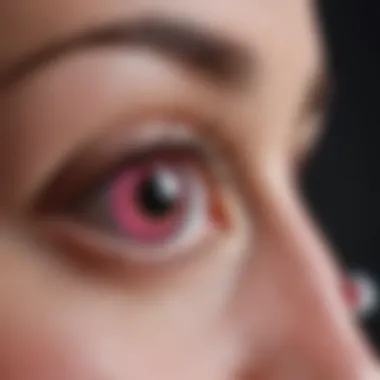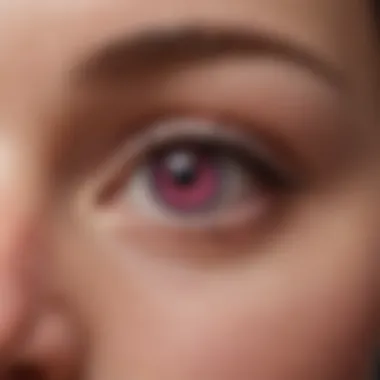Evaluating the Cost of Pink Eye Medication


Summary of Objectives
This article explores the economic aspects surrounding medications for pink eye, also known as conjunctivitis. The primary goal is to analyze different types of treatments available, including their associated costs, and factors that influence these prices. By addressing these key areas, the article aims to inform a diverse audience on the financial nuances involved in selecting appropriate pink eye treatments.
Importance of the Research
Understanding the cost of pink eye medication bears great significance for patients and healthcare professionals alike. Conjunctivitis can arise from various causes, leading to a range of treatment options and costs. With healthcare spending rising, being aware of medication prices helps individuals make informed choices. Furthermore, insights into insurance coverage and generic alternatives can assist in navigating the financial landscape of healthcare.
Results and Discussion
Presentation of Findings
The main types of medications used for pink eye include antihistamines, antibiotics, and antimicrobials. The costs for these medications can vary widely based on factors such as brand, dosage, and whether the version is generic or name-brand. In general, antibiotic eye drops can range from $15 to $60, depending on the formulation. Conversely, antihistamines may run between $10 and $30 for over-the-counter options.
The financial aspect can also be affected by prescription versus over-the-counter availability. Over-the-counter treatments are typically less expensive, but they may not be suitable for all cases of conjunctivitis. Therefore, a healthcare provider’s evaluation is crucial for determining the right treatment.
The economic impact of conjunctivitis treatment is influenced by multiple factors, including the specific type of treatment, geographical location, and availability of insurance coverage.
Implications of Results
From this analysis, it is clear that patients and healthcare professionals should weigh the costs against the benefits of each treatment option. Those without insurance may consider generic alternatives, which can provide significant savings. Additionally, educational resources should stress understanding insurance benefits that cover pink eye treatments, enhancing accessibility to necessary medications. With this knowledge, the risks tied to untreated conjunctivitis can be mitigated.
Understanding Pink Eye
Understanding pink eye, or conjunctivitis, is crucial for recognizing its implications and managing its treatment effectively. This common eye condition can arise from various causes, necessitating a nuanced approach to diagnosis and treatment. By comprehending the types, symptoms, and diagnostic methods associated with pink eye, individuals can make informed decisions regarding medication and care. This knowledge serves as the foundation for many other areas addressed in this article, particularly when assessing the cost of treatments.
Definition and Types
Pink eye, medically known as conjunctivitis, refers to the inflammation of the conjunctiva, which is the thin, transparent layer covering the white part of the eyeball and the inner surface of the eyelids. There are several types of pink eye, each with distinct causes and treatment approaches:
- Viral Conjunctivitis: Caused by viruses, it is often associated with other viral infections, such as the common cold. The condition is highly contagious and usually resolves on its own within a week or two.
- Bacterial Conjunctivitis: Triggered by bacterial infections, this type can lead to more severe symptoms, including pus and significant redness. It often requires antibiotic treatment to clear.
- Allergic Conjunctivitis: Resulting from allergens such as pollen, dust mites, or pet dander, it presents with itching, tearing, and redness. This type typically improves with the use of antihistamines and avoiding the allergen.
- Chemical Conjunctivitis: Exposure to irritants like chlorine in swimming pools or chemicals can irritate the eyes and lead to inflammation. Treatment focuses on rinsing out the irritant and providing soothing measures.
Each type necessitates different treatment options. Understanding these differences is essential for both effective management and cost evaluation.
Symptoms and Diagnosis
Recognizing the symptoms of pink eye is important for timely diagnosis and treatment. Common symptoms include:
- Redness: A typical marker, indicating inflammation and irritation.
- Itching or Burning Sensation: Often reported by patients, especially in allergic cases.
- Tearing or Discharge: Bacterial conjunctivitis frequently produces a thick discharge, while viral types might produce clear fluid.
- Sensitivity to Light: Patients may feel discomfort in brightly lit areas.
Diagnosis of pink eye typically involves a physical examination by a healthcare professional. They may:
- Review Medical History: Understanding prior health issues can help in diagnosing.
- Perform Eye Examination: Checking for redness, swelling, and discharge helps in identifying the type.
- Conduct Laboratory Tests: In certain cases, culture tests may be required to determine if the infection is viral or bacterial.
Diagnosing the specific type of pink eye directly influences treatment choices, which subsequently affects cost and efficiency of care.
Overview of Pink Eye Medications
Pink eye, or conjunctivitis, is a common condition that affects a significant portion of the population. Understanding the medications available for its treatment is crucial for various stakeholders, including patients, healthcare professionals, and researchers. The right medication choice can influence not only the effectiveness of treatment but also the overall recovery time and the associated financial implications.
Effective treatment of pink eye relies on a clear understanding of medication options. This section delves into two main categories: prescription medications and over-the-counter options. Each of these categories has its benefits and considerations that can affect both the healthcare provider's recommendations and the patient's decisions.
Prescription Medications
Prescription medications for pink eye typically include antibiotics and antivirals, depending on whether the cause is bacterial or viral. These medications often offer targeted treatment that can lead to faster recovery times.


- Antibiotic Drops: Commonly used for bacterial conjunctivitis, these solutions help eliminate the infection quickly. Medications like ciprofloxacin and ofloxacin are examples that can treat serious cases effectively.
- Antiviral Medications: For viral conjunctivitis, treatments such as ganciclovir can be prescribed. These may aid in managing symptoms and preventing complications, especially in patients with underlying conditions.
The prescribing of these medications usually comes after a thorough examination and diagnosis by a healthcare professional. It's important to note that while these medications can be effective, they may carry side effects and are often more expensive than over-the-counter alternatives.
Over-the-Counter Options
Over-the-counter options for treating pink eye are generally more accessible and cost-effective compared to prescription medications. They are suitable for mild cases, primarily aimed at alleviating symptoms rather than treating the underlying infection.
- Artificial Tears: These lubricating eye drops help relieve dryness and irritation, which are common symptoms associated with pink eye. They can be found in most pharmacies without a prescription.
- Antihistamines: If allergic conjunctivitis is the issue, over-the-counter antihistamine eye drops can reduce redness and swelling. Brands like Pataday and Zaditor are popular choices.
- Decongestant Eye Drops: These can temporarily relieve redness but should be used sparingly, as overuse can worsen redness in the long term.
Choosing over-the-counter medications can empower individuals to manage their symptoms effectively without the need for a healthcare provider visit unless symptoms persist or worsen.
Factors Affecting Medication Costs
Understanding the factors affecting medication costs is essential for both healthcare providers and patients. Prices for pink eye medications can vary significantly, influenced by a range of elements that must be considered. This section will examine the primary factors that contribute to medication pricing, aiding readers in making informed decisions regarding treatment options.
Manufacturing Costs
Manufacturing costs play a crucial role in determining the price of pink eye medications. These costs include the expenses associated with raw materials, production processes, and quality control. When pharmaceutical companies invest in research and development, the initial costs are often high. This investment is necessary to create effective formulations.
Additionally, the production of generic medications usually incurs lower manufacturing costs. Generic brands often use the same active ingredients as their brand-name counterparts, but they lack the extensive marketing expenses. Therefore, patients may find that these generics are more affordable, contributing to a broader accessibility of treatment.
Market Demand and Supply
The principles of supply and demand significantly influence the prices of pink eye medications. When demand for a particular treatment rises, prices may increase accordingly. This demand can be affected by factors such as seasonal outbreaks of conjunctivitis or widespread awareness of a new medication. Conversely, if there are several options available, market competition can help keep prices down.
Supply chain issues may also impact costs. Delays in production or distribution can lead to scarcity, forcing prices upwards. It is important for consumers to remain aware of local market conditions that may affect the availability and affordability of medications.
Brand vs. Generic Medications
Choosing between brand-name and generic medications is another vital consideration. Brand-name medications typically cost more due to the extensive research, development, and marketing expenses associated with their promotion. Patients may trust a brand name more than a generic alternative due to established reputations.
However, generic medications are generally considered just as effective as their branded counterparts and offer a significant cost advantage. For instance, many organizations now recommend first-line treatment options that include both brands and generics, emphasizing that generics can provide similar relief for patients at a reduced price.
Pricing Structure of Pink Eye Medications
Understanding the pricing structure of pink eye medications is essential for patients and healthcare providers alike. It influences not just individual treatment choices but also factors like accessibility and overall public health. When knowing the costs, patients can make better-informed decisions about their health and financial commitments. Moreover, healthcare providers can offer appropriate recommendations based on medication affordability.
Pricing structures vary significantly based on the type of medications, whether they are prescription or over-the-counter, including considerations like brand or generic versions. Knowledge of these structures can aid in exploring effective treatment options that do not compromise financial stability.
Cost Range of Prescription Medications
Prescription medications for pink eye generally exhibit a wide cost range. On average, these costs can vary from $10 to $100 depending on several factors such as the specific medication, dosage, and pharmacy location. For instance, well-known prescription options like tobramycin and ciprofloxacin may fall into higher price brackets due to their efficacy and brand recognition.
- Most Common Prescription Medications
- Tobramycin
- Ciprofloxacin
- Olopatadine
For many patients, the final out-of-pocket expense can be influenced by their insurance coverage. Many insurance plans may cover a part of the medication costs, leaving patients with varying copay amounts. However, those without insurance might find themselves facing closer to the full retail price. Understanding the medication landscape can help individuals plan financially and find potential alternatives if needed.
Cost Range of Over-the-Counter Medications
Over-the-counter medications for pink eye are generally more affordable than their prescription counterparts. Prices can range from $5 to $40 depending on the active ingredients and the brand. Common options include artificial tears, antihistamines, and other topical treatments that can help alleviate symptoms.
- Popular Over-the-Counter Treatments


- Artificial Tears
- Allergy Eye Drops
- Lubricating Ointments
Although over-the-counter medications offer a less expensive route, patients should consider their specific symptoms and the need for efficacy. These medications might not address underlying infections as efficiently as prescription drugs. It is also essential to keep an eye on the quality of over-the-counter products, as cheaper options may not always deliver expected relief.
Understanding the cost structure of pink eye medications can empower patients to make informed choices, ensuring they access necessary treatments without excessive financial strain.
Insurance Coverage and Medication Costs
The discussion around insurance coverage and medication costs is vital in understanding how patients manage the financial burden associated with pink eye treatment. For many individuals, the availability and extent of insurance coverage play a crucial role in determining both accessibility to necessary medications and overall health outcomes. The intersection of insurance plans and medication costs can influence treatment choices, often pushing patients towards either over-the-counter options or delaying essential care due to perceived expenses.
Understanding Insurance Plans
Understanding the specifics of insurance plans is essential for patients when dealing with pink eye. Each insurance plan comes with distinct features, premiums, deductibles, and copays. Here are several key aspects:
- Coverage Limits: Many plans have specific formularies that outline which medications are covered. Knowing whether a given pink eye medication falls under this list is crucial for patients.
- Network Restrictions: Some health plans only cover medications obtained through in-network pharmacies. This can lead to higher costs if a patient chooses to go outside the network.
- Prior Authorization: Certain medications may require prior approval from the insurance provider before coverage kicks in. This process can cause delays in treatment.
Patients are encouraged to contact their insurance provider directly to clarify any doubts and confirm what medications are covered under their plan. This proactive approach may help prevent unexpected expenses associated with treatment.
Out-of-Pocket Expenses
The term out-of-pocket expenses encompasses all costs that patients must pay directly, without the help of their insurance. These can significantly vary based on the patient’s insurance plan and the type of medication prescribed. Some common types of out-of-pocket expenses include:
- Deductibles: This is the amount a patient must pay before the insurance begins to cover medications. High deductible plans may lead to considerable initial costs for treatment.
- Copayments: Generally, patients will have to pay a copay for medications, especially for prescription options. Depending on the medication's tier within the insurance plan, copayment structures can differ.
- Coinsurance: In some cases, patients may also face coinsurance costs, where they pay a percentage of the medication cost rather than a fixed copay.
Understanding the components of out-of-pocket expenses allows patients to better anticipate costs and make informed decisions regarding their treatment options. This clarity can ultimately affect adherence to prescribed treatments, especially if patients choose to forgo medication based on price alone.
Overall, it is clear that a thorough understanding of insurance coverage and medication costs is integral in managing the financial implications of treating pink eye. Patients must navigate both their insurance plans and the out-of-pocket expenses to ensure access to the most effective treatments.
Savings Options for Pink Eye Treatments
Understanding savings options for pink eye treatments is essential for patients facing financial constraints. This section explores how individuals can manage costs without compromising their health. The pursuit of affordable medication is not just about saving money but also about ensuring access to necessary treatments.
Utilizing Discount Programs
Discount programs provide a valuable resource for patients seeking economic relief. Many pharmacies and manufacturers offer these programs directly or through third-party organizations. Patients can benefit significantly by enrolling in discount schemes tailored specifically for eye care products.
A notable point is that some pharmacy chains, for example Walgreens and CVS, conduct their own discount card programs, making medications more accessible.
The following are a few aspects regarding discount programs:
- Eligibility Requirements: Often, these programs require proof of income or lack of insurance.
- Range of Discounts: Discounts can vary widely, sometimes reaching up to 80% off the regular price.
- Ease of Access: Many programs allow patients to sign up online, enhancing convenience.
Patients should investigate these options during their visits to healthcare providers or pharmacies. A quick inquiry can provide information about available discounts.
Comparative Shopping for Medications
Comparative shopping is an effective strategy to minimize medication costs. Patients should not settle for the first price they encounter. The prices for pink eye medications can be inconsistent across different pharmacies and online platforms.
Key elements to consider include:
- Price Variation: Prices at local pharmacies can differ dramatically. Using price comparison websites or apps can be beneficial to locate the best available deal.
- Consideration of Generic Options: Generic medications generally cost less than their brand-name counterparts. For example, instead of opting for the brand name Alcon Pataday, considering the generic equivalent can yield significant savings.
- Online Pharmacies: Reputable online pharmacies often offer competitive rates. However, it is crucial to ensure that they are licensed and trustworthy before making any purchases.
In addition, patients should consult with their healthcare providers to understand if their prescribed treatment has a more affordable alternative. This practice not only aids in cost savings but also promotes informed decision-making concerning treatment options.
By utilizing discount programs and engaging in comparative shopping, patients can significantly reduce the financial burden associated with pink eye treatments. Access to effective medication does not need to be an expensive endeavor.


Consumer Experience and Medication Costs
Understanding the balance between consumer experience and medication costs is critical in the landscape of healthcare. As patients navigate treatment options for pink eye, their experiences directly influence perceptions of affordability and accessibility. This section aims to elucidate the dynamic relationship between patient feedback and the economic considerations of pink eye treatments.
Cost is a major factor that shapes the patient experience. A significant number of patients express concerns regarding the out-of-pocket expenses associated with medications. For many, the price of treatment affects their willingness to seek medical help. Hence, it is paramount to address these issues directly, as they intersect with the choice of medication. This creates an environment where the quality of care needs to be weighed against financial realities.
Healthcare providers must be aware of patient perspectives on medication affordability. This broader understanding can lead to better patient outcomes. When patients feel supported in their financial considerations, they are more likely to adhere to treatment regimens and follow through with consultations. Moreover, the experience patients have can either promote trust and satisfaction in the healthcare system or foster feelings of frustration and discouragement.
The focus on consumer experience also encourages pharmacies and healthcare providers to adopt more transparent pricing strategies. Making cost information readily available can empower patients, allowing them to make informed decisions about their health.
Patient Perspectives on Medication Affordability
Patients often report mixed feelings about the affordability of pink eye medications. Many express the view that even minor conditions can accrue high costs due to medications like antihistamines or antibiotic drops. Factors such as insurance coverage and the availability of generics can significantly affect these perspectives.
- Insurance Coverage: Many patients struggle with understanding their insurance plans. Sometimes essential medications are not well covered, forcing patients to pay more than expected.
- Generic Options: Patients often favor generic medications as viable alternatives that can help reduce costs, yet not all doctors readily inform them about these options.
Research shows that awareness of alternatives plays a vital role in patient decisions. Notably, a significant percentage of patients report that they would choose different treatment if they were made aware of lower-cost alternatives.
"Understanding options has greatly altered my approach to treatment. I wish had known about generics sooner."
- Patient Testimonial
Impact of Cost on Treatment Choices
The cost associated with pink eye medications can have a profound impact not only on patient choices but also on overall health outcomes. When faced with high prices for treatments, patients might delay seeking medical help or opt for suboptimal treatments. These choices can lead to exacerbated conditions or prolonged discomfort.
- Delaying Treatment: Some patients may avoid necessary consultations due to anticipated costs, further complicating their health.
- Choosing Inadequate Alternatives: In some instances, patients may choose over-the-counter solutions which may not be sufficient to combat the specific type of conjunctivitis they are facing.
Healthcare professionals should address these challenges by seeking to provide more guidance about costs. Continuing education for providers about how costs affect patient choices can improve overall treatment compliance and patient health.
By focusing on these elements, a bridge can be created between cost and care quality, which will invariably enhance the overall patient experience in relation to pink eye treatments.
Future Trends in Medication Costs
The landscape of medication costs is constantly evolving, particularly in the area of treatments for pink eye. Understanding future trends in medication costs is crucial, as it informs healthcare providers, patients, and policymakers about what to expect in the coming years. This knowledge can influence treatment choices, budgeting for healthcare, and even research into innovative therapies.
As previous sections have discussed, factors such as manufacturing costs, market demand, and the comparison between brand and generic medications have significant impacts on pricing. However, looking forward, it is essential to consider potential innovations and economic shifts that could alter these established patterns.
Innovations in Treatment Approaches
Recent advancements in medical technology have led to new treatment options for pink eye. For example, the development of novel drug delivery systems, such as sustained-release formulations, enhances the efficacy of existing medications. These innovations can improve user compliance and therapeutic outcomes, potentially resulting in lower overall costs through reductions in the frequency of dosing or the severity of symptoms.
Additionally, research into biosimilars, which are comparable to biologic medicines, is gaining traction. This could lead to more affordable alternatives for expensive treatments in the future.
"Innovations in treatment approaches not only promise better patient outcomes but may also drive changes in cost structures for pink eye medications."
Predicted Changes in Pricing Models
Predicted changes in pricing models for medications are shaping how costs may be structured. One significant trend is the increasing focus on value-based pricing. This approach ties medication costs to the clinical outcomes they provide. As stakeholders—such as insurers and healthcare providers—begin to embrace this model, medications that demonstrate high efficacy may be valued differently in the marketplace.
Furthermore, the rise of telemedicine and direct-to-consumer services could alter the ways patients obtain their medications. This change can possibly lower overhead costs and create opportunities for consumers to access more affordable treatment options. As these methods become more integrated into healthcare delivery, it may lead to a more competitive pricing environment that benefits consumers.
Epilogue
In evaluating the cost of pink eye medication, it is essential to understand the implications of choosing the right treatment and navigating the complexities of healthcare economics. This article has laid out various facets of costs associated with pink eye, including perspectives from patients and insights into market dynamics.
The discussion highlights that costs are not merely numeric; they carry profound significance for treatment choices and overall patient experiences. By being informed of the different types of medications available, including both prescription and over-the-counter options, patients can better advocate for their health and financial concerns. Insurance coverage adds another layer, affecting out-of-pocket expenses significantly. Understanding one’s insurance plan can guide decision-making in accessing medications.
Moreover, recognizing brand versus generic medications can lead to substantial savings without compromising care quality. This knowledge is crucial amid the rising costs of healthcare.
The insights into future trends bring forward potential shifts in how medications might be priced and the innovations that could emerge in treatment options.
Thus, the key takeaway from this article is the necessity of a comprehensive understanding of the economic landscape surrounding pink eye treatments. Access to information empowers patients and healthcare providers alike to make informed choices—choices that not only influence health outcomes but also financial wellbeing. Therefore, the importance of ongoing research and analysis in this field cannot be overstated. Remaining vigilant in these matters enables better preparation and response to the evolving dynamics of medication costs.















